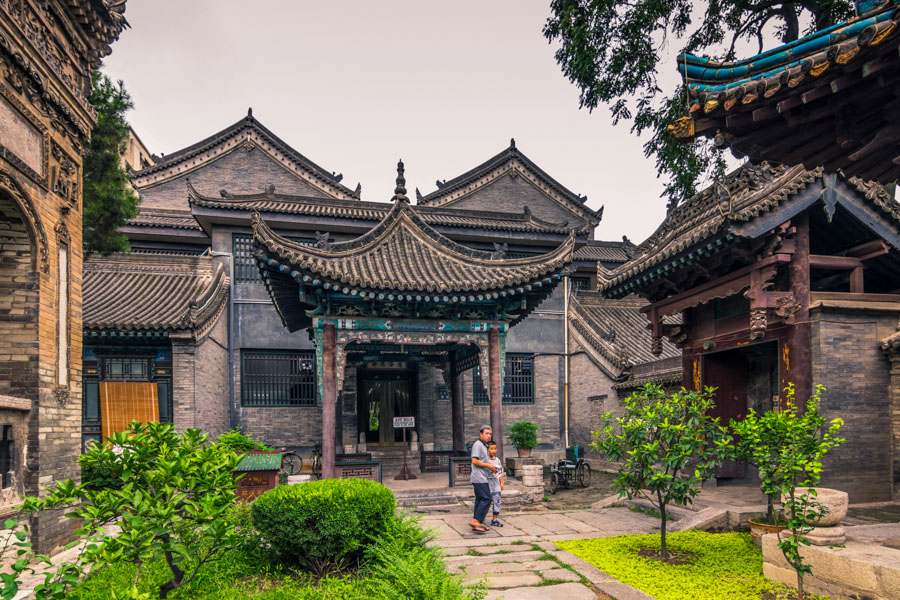
The Great Mosque of Xi'an (西安清真大寺) in China (中华人民共和国) is the focal landmark of the Muslim Quarter (回坊) and its most significant place of worship, located beside the bustling Muslim Bazaar. Within its walls, green courtyards offer a serene retreat from the lively streets outside, creating a peaceful setting ideal for reflection and unhurried walks.
Great Mosque of Xi'an Tours
The Great Mosque of Xi'an is one of the city’s most remarkable religious monuments and a symbol of the cultural heritage of its Muslim community.
A tour of the Great Mosque offers more than just a visit to a historic site – it provides insight into the traditions and daily life of the Hui people, descendants of Arab and Persian merchants who settled in Xi’an nearly 13 centuries ago. You will learn how these traders, who once guided caravans laden with treasures along the Silk Road, chose to make the ancient Chinese capital their home. Within the mosque grounds, you’ll encounter members of the local community for whom prayer here is a cherished routine and the complex itself an object of deep reverence. The architecture reveals a harmonious blend of Islamic religious tradition and Chinese artistic style – a striking expression of both beauty and spirituality.
A visit to the Great Mosque is included in every Xi’an sightseeing tour, as it is here, in the heart of China’s ancient capital, that the spirit of centuries of history can be truly felt. Discover one of Xi’an’s most iconic landmarks as part of a multi-day journey through China.
Best Time to Visit the Great Mosque of Xi'an
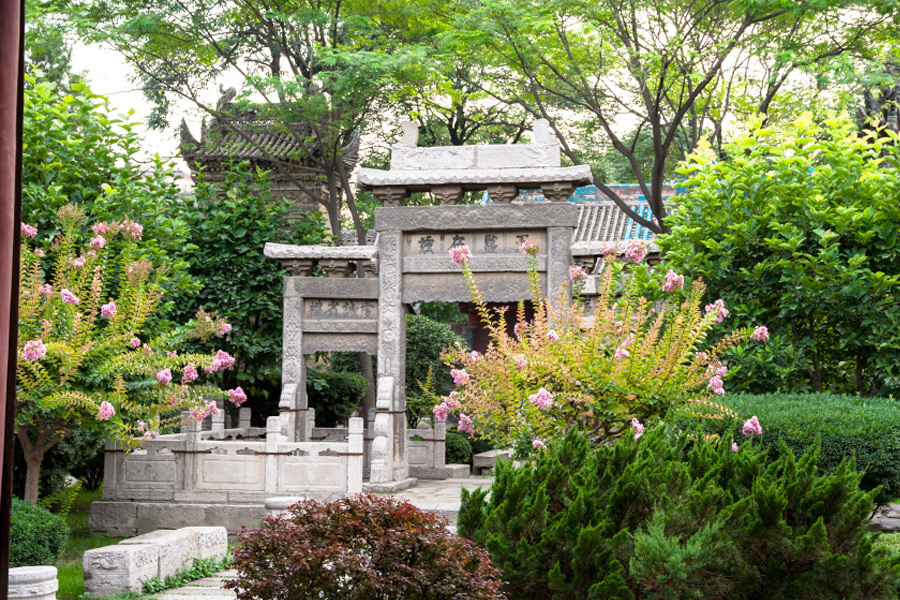
The best time to visit the Great Mosque is in spring or autumn, when the streets of the Muslim Quarter are bathed in soft sunlight and the weather is ideal for walking and sightseeing.
If you are Muslim or seeking unique cultural and spiritual experiences, you may wish to plan your visit to coincide with one of the major dates on the Islamic calendar. These occasions bring a special atmosphere to the mosque and its surroundings:
- Ramadan (holy month of fasting) – Each evening, believers gather for prayers, and after sunset, the communal iftar meal begins. The air fills with the aromas of freshly baked flatbreads, rich broths, and sweet pastries, while the streets bustle with warmth and hospitality.
- Eid al-Fitr (Festival of Breaking the Fast) – Marking the end of Ramadan, this day draws hundreds of worshippers to the mosque for collective prayers. Outside, the neighbourhood buzzes with activity, filled with festive scents and lively crowds.
- Mawlid al-Nabi (Birthday of the Prophet Muhammad) – On this day, the mosque hosts special prayers, sermons, and recitations of poetry and teachings. The atmosphere is calmer and more intimate, yet deeply solemn.
During such celebrations, the mosque comes alive with voices, prayers, and movement, offering visitors a chance to witness living traditions of the Hui Muslim community.
If you prefer a quieter experience, consider visiting on a regular weekday. Outside major holidays, the mosque’s courtyards are peaceful and cool, with only the rustle of leaves and the occasional footsteps of visitors. It is an ideal time to admire the intricate carved gates and pavilions and appreciate the harmony of the space without distraction.
Whichever time you choose, the Great Mosque of Xi’an offers beauty in every season – whether in the lively colours of celebration or the calm elegance of stillness.
Opening Hours
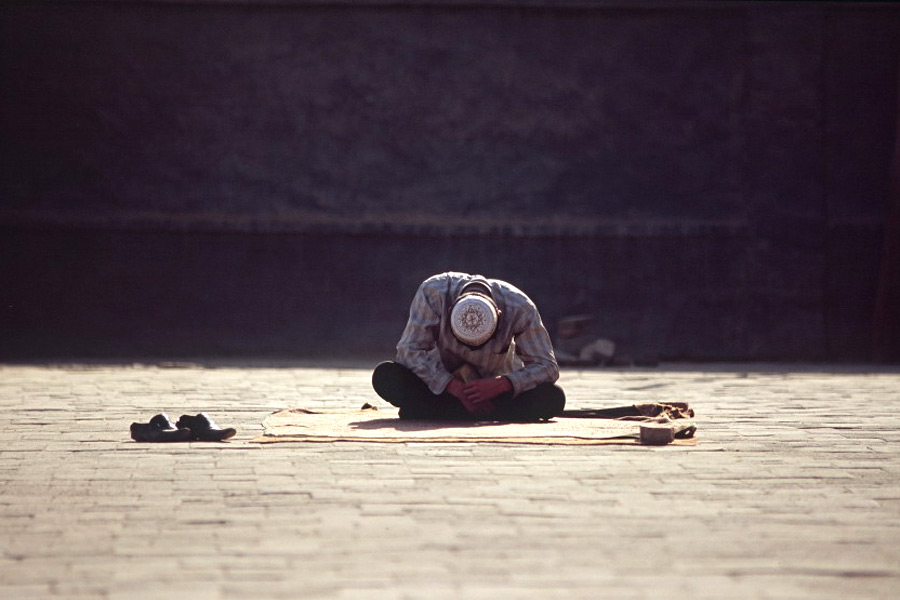
The Great Mosque is open to visitors year-round. As in other parts of the Muslim world, prayers are held five times a day, with exact times varying according to the season and the sun’s position.
Visiting Hours:
- March to November: 09:00 to 20:00
- December to February: 09:00 to 18:00
Ticket Prices (for tourists)
- March–November: 25 CNY/RMB (approximately $3.50, £3.00, €3.00)
- December–February: 15 CNY/RMB (approximately $2.00, £1.55, €2.00)
Admission is free for Muslims.
Practical Additional Information
- Entrance Payment: Tickets can only be purchased in cash; therefore, it is advisable to bring small denominations of money, as international cards are not accepted.
- Average visiting time: 30 to 40 minutes.
- Reservations: Not required.
- The complex includes five courtyards, which house 20 buildings that are open to the public.
- Only Muslims may enter the prayer hall.
History of the Great Mosque of Xi'an
The Great Mosque of Xi'an was founded in 742 AD, during the Tang Dynasty (唐朝), when Xi'an was at the height of its prosperity. At the time, the city was the largest trading hub on the Silk Road, attracting people from across the known world. Muslim merchants and traders from Central Asia, many of them followers of Islam, frequently visited Xi’an and gradually settled there. Over time, they formed a close-knit Hui community that continues to honour the traditions of its ancestors nearly 13 centuries later. Built in the heart of the Muslim Quarter, the mosque became a symbol of unity for Muslim immigrants, and it remains a place where local residents gather to pay tribute to their history.
Over the centuries, the mosque complex underwent significant changes, with new elements added during at least four major renovations in the mediaeval period. It assumed its current form, during the Ming Dynasty (明朝) (1368 to 1644). In 1956, the site was designated a provincial-level protected monument, and in 1988, it was elevated to the status of a national monument. Today, the Great Mosque stands as both the spiritual heart of Xi’an’s Hui community and a lasting symbol of the city’s cultural diversity.
Architectural Marvels of the Great Mosque of Xi'an
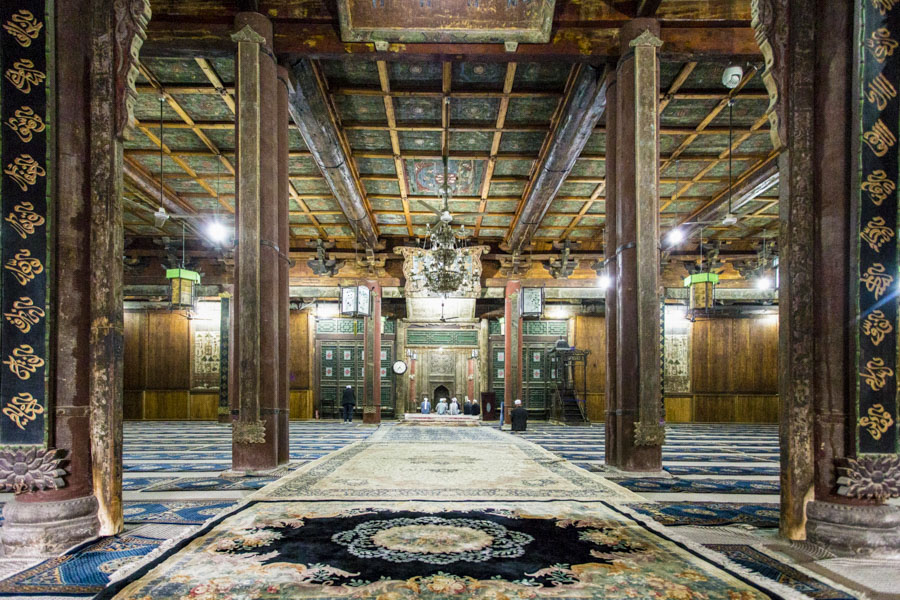
The Great Mosque of Xi'an is renowned for its distinctive architecture, which blends Chinese design traditions with Islamic religious requirements. Unlike many mosques, it has no minarets or large domes topped with crescents. Instead, its skyline features tiered pagodas with tiled roofs, set among green courtyards. At first glance, it may resemble a Buddhist temple or a Taoist monastery. Yet closer inspection reveals details characteristic of Islamic art: plant-pattern bas-reliefs on walls and gates (in keeping with the Islamic prohibition on depicting people and animals) and stone carvings of Arabic script. These inscriptions are rendered in a uniquely Chinese way – read vertically, from top to bottom.
Despite its outwardly Chinese features, the Great Mosque is an active place of worship built entirely according to Islamic tradition and orientated toward Mecca. The complex is laid out in five courtyards aligned along an east–west axis, ensuring the proper positioning of the mihrab in the western wall of the westernmost building. Within the enclosure, there are more than twenty structures.
The first courtyard is the simplest, enclosed by a brick wall and two side gates, and it features a grand wooden ceremonial arch decorated with glazed tiles from the 17th century, which is supported by six columns.
Beyond it lies the second courtyard, distinguished by a stone arch and pavilions with commemorative steles with inscriptions by revered calligraphers Mi Fu of the Song Dynasty and Dong Qichang of the Ming Dynasty.
The third courtyard leads to the octagonal Pavilion for introspection, The Xingxin Tower, the tallest structure in the complex, often mistaken for a minaret as a spiritual focal point within the mosque. It contains an impressive array of ancient steles. This area also houses auxiliary facilities, including rooms for ablutions, lecture halls for future imams, kitchens, offices, and the residence of the mosque’s abbot.
The fourth courtyard is home to the Phoenix Pavilion, which represents rebirth and renewal, enchanting visitors.
The fourth and fifth courtyards open onto the main building – the prayer hall. Designed in traditional Chinese style, it features a roof of azure-blue glazed tiles, a colour historically associated with high status and reverence. Measuring 32.9 by 27.5 metres (approximately 107.25 by 90.33 feet), the hall has no windows but is illuminated by a bright mihrab and a richly decorated ceiling adorned with more than 600 intricate coloured panels. It can accommodate over a thousand worshippers at once.
The Great Mosque does not imitate any single Chinese temple but draws inspiration from the architectural traditions of 15th- 16th-century temple complexes. Visitors will notice elements typical of Chinese monasteries, such as spirit screens, arches, and towers. Above all, however, the mosque stands as a remarkable example of how Islamic spiritual life has harmoniously adapted to the Chinese cultural and architectural setting, becoming an integral part of the historic landscape of Xi’an.
Things to Do Around the Great Mosque of Xi'an
Places to Visit Around the Great Mosque of Xi'an
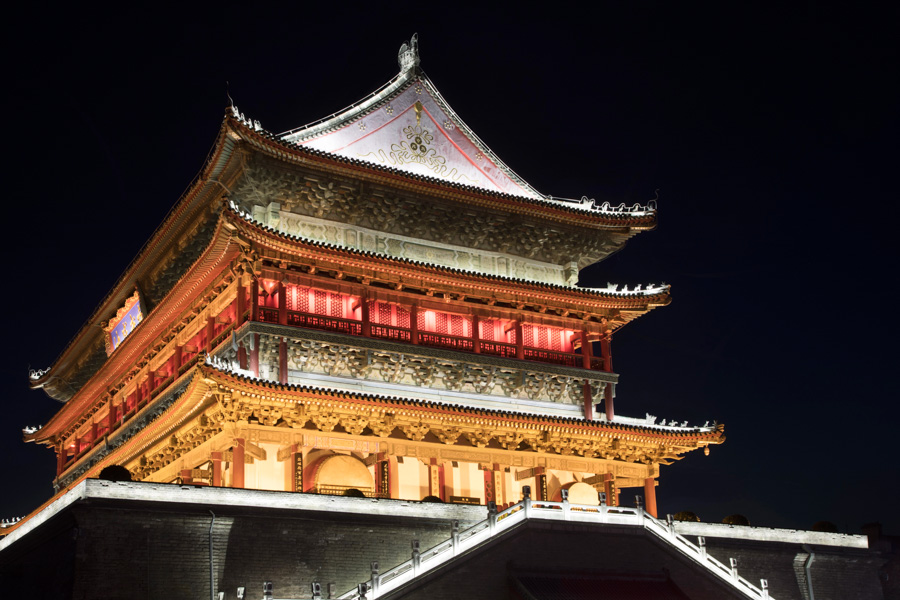
After exploring the Great Mosque, take time to discover its authentic surroundings. Within a few hundred metres (approximately 328.08 feet), you’ll find narrow lanes, historic buildings, and hidden corners that offer a glimpse into Xi’an’s past. From here, it’s an easy walk to some of the Muslim Quarter’s most interesting attractions:
Huajue Lane (化觉巷) – This is the main route to the Great Mosque through the winding alleys of the Muslim Quarter. After your visit, allow time for a leisurely stroll along this colourful lane. Its low stalls, the scent of spices in the air, distinctive shop displays, and merchants ready to bargain evoke the intimate charm of a traditional bazaar.
Beiyuanmen Street (北院门) – Just a hundred metres (approximately 328.08 feet) from the Great Mosque, this bustling thoroughfare is famous for its rich variety of local cuisine. Here you can try tender lamb skewers, fragrant Chinese roujiamo burgers with juicy fillings, refreshing liangpi noodle salads, and many other street food specialities.
Drum Tower (鼓楼) – One of the symbols of old Xi’an, this elegant structure on a high stone base once served as the city’s clock, marking the hours after sunset. Today, it draws visitors with its harmonious design and panoramic views of the historic centre, planned in precise symmetry. A short visit here after the mosque will reward you with fresh impressions and excellent photo opportunities.
Gao’s Grand Courtyard (Gaojiadayuan) – This Ming dynasty residence once belonged to the prominent Gao Yuesong family. Stepping inside feels like entering feudal China, with well-preserved architecture and interiors. Its main highlight is the traditional shadow theatre, one of the oldest forms of Chinese folk art, with performances staged approximately every hour.
How to Get to the Great Mosque of Xi'an?

The Great Mosque is located in the heart of Xi'an's Muslim Quarter, inside the ancient City Wall.
By subway
The quickest and most convenient way to reach the Muslim Quarter is by subway. Take Line 2 to the Bell Tower (Zhonglou/钟楼) Station, use Exit B, and walk directly toward the Drum Tower, northwest of the Bell Tower. From there, Beiyuanmen Street begins, which is a lively promenade lined with street food stalls and historic architecture. It is only about a five-minute walk from the station to the centre of the bustling bazaar.
By bus
You can also reach the Muslim Quarter by bus, as many routes pass through this area. Your stop is the Bell Tower (Zhonglou/钟楼) in the city’s central square. From there, head toward the Drum Tower and turn onto Beiyuanmen Street, where the vibrant atmosphere of the quarter quickly surrounds you.
Suitable routes:
Bell Tower South: 6, 11, 16, 26, 29, 35, 46, 208, 209, 603, 605, 608, 609, 616
Bell Tower West: 15, 32, 43, 45, 201, 215, 218, 221, 222, 251, 252, 286, 300, 604, 611, 612, 618, 622
Bell Tower North: 4, 12, 37, 229, 235, 600, 618
From the bus stop, follow the crowd toward the Drum Tower, then continue along Beiyuanmen Street. Within minutes, you will find yourself in the heart of the famous quarter, surrounded by eateries and souvenir shops.
Once inside the Muslim Quarter, you can either head directly to the Great Mosque along Huajue Lane or take a leisurely stroll down Beiyuanmen Street, then turn left onto Xiyangshi Street and left again at its intersection with Huajue Lane.
Tips for an Optimal Visitor Experience
How to Dress for a Visit to the Great Mosque of Xi'an
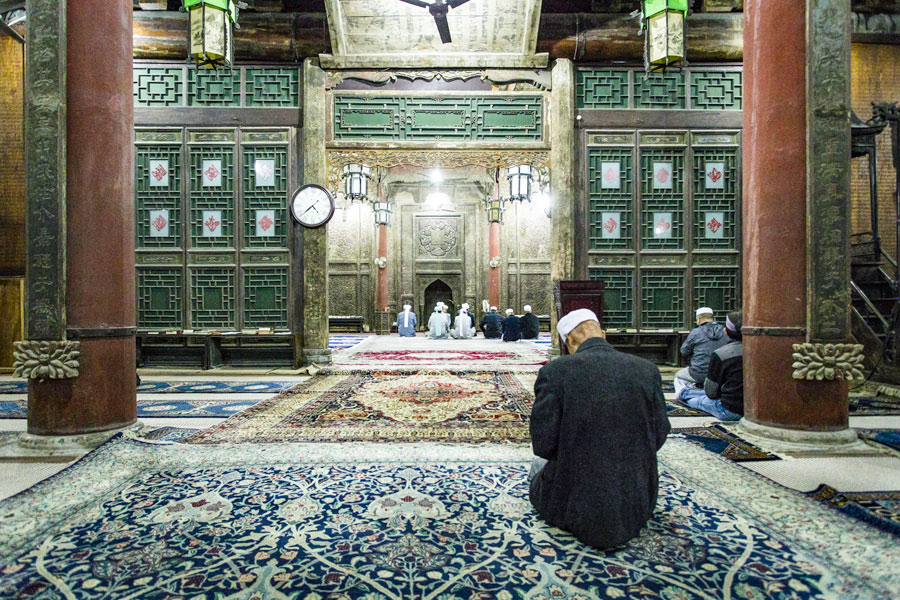
The Great Mosque of Xi'an is an active place of worship for the local Muslim community. Even as a tourist, it is important to respect religious traditions by wearing modest clothing. Doing so is simple and ensures you feel comfortable without drawing unnecessary attention.
For Men:
- Long trousers (avoid shorts)
- Shirt or T-shirt with sleeves (no tank tops)
For Women:
- Dress, skirt, or trousers that cover the knees.
- Top with sleeves (short or long) and no low neckline.
- A headscarf is not required but is appreciated as a sign of respect.
General Dressing Recommendations:
- Avoid revealing clothing such as miniskirts, tops exposing the midriff or shoulders, and sheer fabrics.
- In hot weather, carry a light shawl or scarf to cover your shoulders if needed.
Photography and Videography
Taking photos or videos is permitted; however, it is advisable to seek permission before photographing individuals and to avoid taking photos and videos of worshippers during prayer times.
Visitor Facilities
- Areas for reflection or prayer are available on the mosque site, and restrooms are located nearby the mosque ensuring a comfortable visit for all.
The Great Mosque of Xi'an is a remarkable destination that offers a unique blend of history, culture, and spirituality, making it a must-visit for anyone exploring Xi'an.

